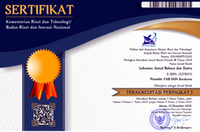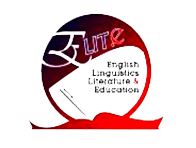REITERATIONS IN 'PRIANGAN SI JELITA' AND THEIR IMPLICATIONS TOWARD INDONESIAN LANGUAGE LEARNING AT SECONDARY SCHOOLS (REITERASI DALAM 'PRIANGAN SI JELITA' DAN IMPLIKASINYA PADA PEMBELAJARAN BAHASA INDONESIA DI SMP)
DOI:
https://doi.org/10.22515/ljbs.v3i1.1110Keywords:
lexical cohesion, reiteration, poems, learningAbstract
This research studied the use of reiteration in che ollection of poems Priangan Si Jelita. The object of this research is reiteration which consist of repetition, synonymy, metonymy, and hyponymy. This research used both theoretical and methodological approaches. The former was discourse analysis whereas the latter was qualitative-descriptive approach. The result of analysis shows that the strength and beauty of the forms and meanings of the poems in Priangan Si Jelita are mostly built by the lexical cohesive elements within, particularly reiteration covering repetition, synonymy, metonymy, and hyponymy. The most dominant reiteration in the poems is repetition. This research has an implication toward Indonesian language learning for class IX students of junior high school in the material of paraphrasing poems in accordance with the structure and principles of texts in written formDownloads
References
Aghdam, Samira Hashemi & Yaser Hadidi. 2012. “Cohesion and Coherence in Political Newspapers and Discussion Sections of Academic Articlesâ€. International Journal on Studies in English Language and Literature (IJSELL) 3: 11-22
Alwasilah, A. Chaedar. 2006. Pokoknya Kualitatif: Dasar-dasar Merancang dan Melakukan Penelitian Kualitatif. Jakarta: PT Dunia Pustaka Jaya
De Beaugrande, Alain-Robert. 1981. Introduction to Discourse. London and New York: Longman
Depdiknas. 2008. Kamus Besar Bahasa Indonesia (KBBI). Jakarta: Gramedia
Haris, Siti NF & Melor Md Yunus. 2014. “The Use of Lexical Cohesion among TESL Postgraduate Students in Academic Writingâ€. Journal of Education and Human Development, 3 (2): 847-869.
Herianah. 2014. “Kohesi Gramatikal dan Leksikal Dalam Wacana Puisi Tadarusku Untukmu Karya Sus S. Hardjonoâ€. Jurnal Metalingua 12 (1): 57-69
Kridalaksana, Harimurti. 2001. Kamus Linguistik. Jakarta: Gramedia Pustaka Utama
Malgwi, Grace. 2016. “A Study of the Character of Lexical Cohesion in ESL Texts.†Literacy Information and Computer Education Journal (LICEJ) 7 (1): 211-214.
Malah, Zubairu. 2015. “Lexical Cohesion in Academic Discourse: Exploring Applied Linguistics Research Articles Abstracts.†Research Journal of English Language And Literature, 3 (4): 291-299
McRae, John. 1998. The Language of Poetry. London : Routledge
Pateda, Mansur. 2010. Semantik Leksikal. Jakarta: Rineka Cipta
Putra, Anggit HM. 2014. “Analisis Kohesi Gramatikal Dan Leksikal dalam Novel Kirti Njunjung Drajat Karya R. Tg. Jasawidagdaâ€. Jurnal Program Studi Pendidikan Bahasa dan Sastra Jawa, 4 (1): 45-50
Ramadhan KH. 1975. Priangan Si Jelita. Jakarta: Pustaka Jaya
Rani, Abdul, Bustanul Arifin & Martutik. 2004.. Analisis Wacana: Sebuah Kajian Bahasa dalam Pemakaian. Malang: Bayumedia Publishing
Sudaryanto. 1993. Metode dan Aneka Teknik Analisa Bahasa. Yogyakarta: Duta Wacana University Press
Zaimar, Okke Kusuma Sumantri & Ayu Basoeki Harahap. 2011. Telaah Wacana: Teori dan Penerapannya. Jakarta: Komodo Books
Downloads
Published
Issue
Section
License
The copyright of the received article shall be assigned to the publisher of the journal. The intended copyright includes the right to publish the article in various forms (including reprints). The journal maintains the publishing rights to published articles.
In line with the license, the authors and users (readers or other researchers) are allowed to share and adapt the material only for non-commercial purposes. In addition, the material must be given appropriate credit, provided with a link to the license, and indicated if changes were made. If authors remix, transform or build upon the material, authors must distribute their contributions under the same license as the original.







